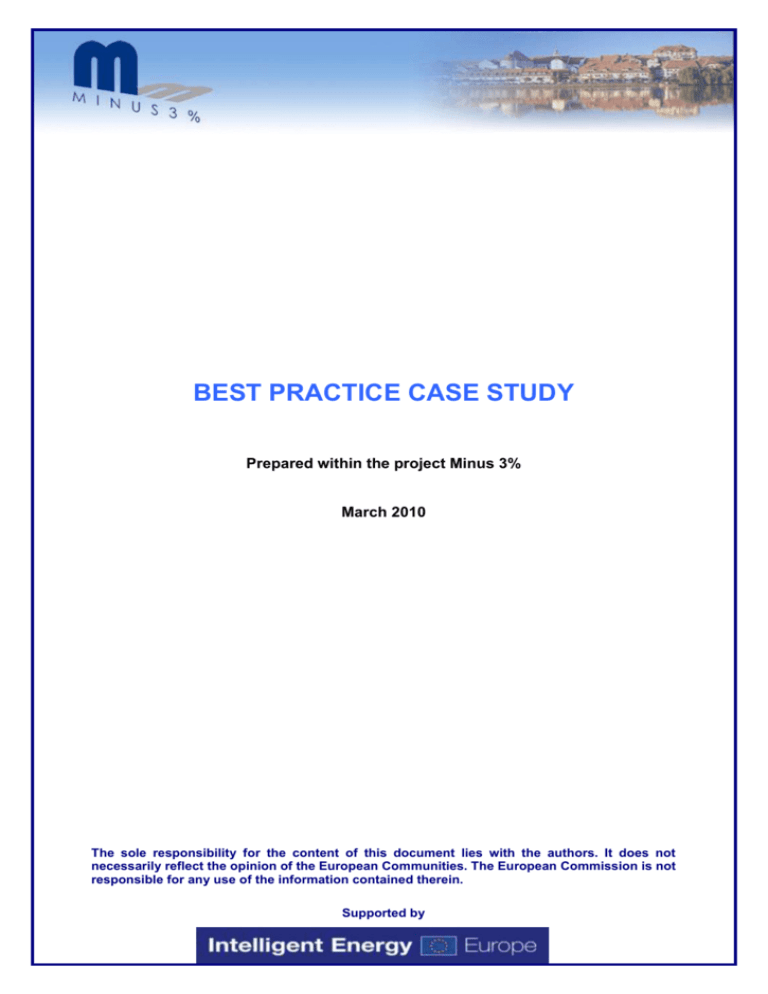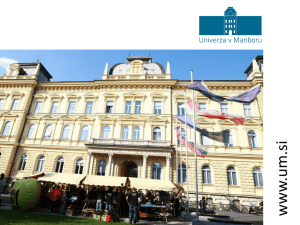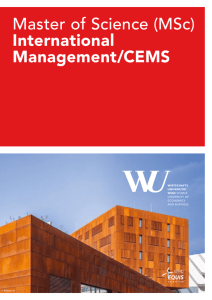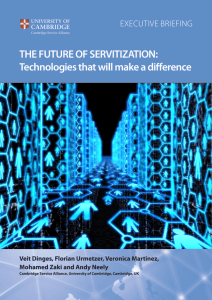Energy management of public buildings & educational campaign
advertisement

BEST PRACTICE CASE STUDY Prepared within the project Minus 3% March 2010 The sole responsibility for the content of this document lies with the authors. It does not necessarily reflect the opinion of the European Communities. The European Commission is not responsible for any use of the information contained therein. Supported by 1. Introduction The aim of this case study is to show the most promising energy efficiency measures identified within the project Minus 3% among participating cities. The following case studies are examples of possible measures bringing large energy saving measures coupled with environmental benefits and economy analyses. 2. Case studies 2.1 Slovenia – City of Maribor Energy management in public building and educational campaign in the city of Maribor 2.1.1 Project idea To achieve EU goals regarding energy savings and reduction of GHG emissions at the local lavel, Energy agency of Podravje launch the project oriented in the field of reducing energy consumption in public buildings and to raise awareness of the importance of energy saving among the pupils in the city of Maribor. First part of the project is based on softwere tool Central Energy Management System (CEMS) developed by a Slovenian private company Adesco and it works on the general data of the buildings, climate characteristic, energy using and consumption. It can take into acount saving measures, price of energy, possible savings and CO2 emission. It gives the possibilities to follow the progres of savings determined in savin performance contracting financing system. Picture: Front page of the software of CEMS Each building has its own system code for data input and for the overview of some individual results. In the first phase, in September 2008, we installed the CEMS in 28 primary schools and 32 kindergartens in the city of Maribor and we were the first one in Slovenia. Installation was accompanied with information and educational campain for people in different municipal sectors, for school headmasters and for financial officers at schools about importance of energy matters in public buildings regarding the energy use, energy efficiency, costs, living conditions, GHG reduction and other environmental benefits. Special education about Supported by electronic energy bookkeeping and CEMS use was also organized for them. Since January 2009 every school and kindergarten in the city is constantly (every month) manually inputting the energy consumption data into the system. EnergaP was collecting and inputting the energy data of the schools and kindergartens from the year 2007 and 2008 into CEMS system. EnergaP as a central point is able to see all the objects data and is able to provide the analysis, results and also benchmarking results. We can calculate and draw the specific indicators for each school regarding its area, number of pupils, weather conditions, CO2 emissions, etc. We also provide the information on the measuremets for saving – noninvestment and investment ones. The municipality department, that is responsible for financing the schools and kindergartens can, with the help of CEMS, produce the reports of energy cost and future energy needs and use it in budgetary planning. Picture: Use of kWh of electricity and costs of it in two years period of time in selected building Furthermore, the municipality can use the data for decision on which school is the most appropriate for retrofitting. With the use of CEMS common public procurement for heating oil for all schools and kindergartens in Maribor for year 2010 and 2011 was already carried out because the data were already collected. In 2010 Energap will set the limits for maximum energy use per building and within the system every three months the maximum energy use will be set a bit lower to push the user to implement the saving measurements that will be proposed to them. At the same time we are searching for finances (credits, PPP agreements, structural funds) and prepare the documentations to refurbish the buildings The system is upgraded with the possibilities of calculating the economic analysis of different investments regarding energy saving potentials as a base for financial agreements. Second part of the project is oriented in the educational field. Since 2007 we are organizing so cold ˝Energy days˝ for schools with different energy related workshops where we also include the gathered data from the CEMS. Picture : Learning about energy bookkeeping Supported by Picture 10: Learning about thermal protection using thermographic camera. 2.1.2 Description of the situation before realisation of EE and/or RES measures After EnergaP´s establishment in June 2006 agency started with active information and education campaign, data collection and energy strategy preparation. As a result of campaign City Council adopted Local energy concept in January 2009. One of the main obligatory goal within the concept is to save at least 3% of energy in public sector with special attention to schools where the real energy saving measurement are connected with school pedagogical activities to achieve sustainable educational aims. To reach above – mentioned goals one of the first proposed activities was energy renovations of public buildings because approx. 75% of them are not in good energy saving conditions. Since schools and kindergartens are fully financed from public budget and all the investment and savings are directly linked to that we use this object as a starting point of the project. EnergaP introduced the Central Energy Management System in September 2008. Since 2007 we have organized so cold ˝Energy days˝ for primary schools with different environmental and energy related workshops for pupils. 2.1.3 Data on proposed EE/RES measures: Supported by The aim of the project is to save at least 3% of energy in public sector and to educate young population, to become more responsible energy consumers. With the use of Central Energy Management System (CEMS) as one of the strategic tool for achieving the target we are able to identify cost anomalies, mistakes and weak points in the buildings. By comparing different buildings we can determine which building is the most appropriate for retrofitting, where the employee´s behaviour is irrational, etc. In the future, using the CEMS, we will be able to calculate the economic analysis of different investments regarding energy saving potential. With energy bookkeeping as a part of the CEMS we would like to achieve higher awareness level of the importance of reducing energy consumption among users of the buildings. Furthermore, one of the project objective is also to reduce the CO2 emissions. In the first phase, in September 2008, we installed the CEMS in 28 primary schools and 32 kindergartens in the city of Maribor and we were the first one in Slovenia. In December 2009 the CEMS were installed in 10 other public buildings in Maribor (health care, sport’s halls, cultural homes). In january 2010 we have started to implement the system also in two neighbouring municipalities (20 buildings) and is well accepted and is also working in the same central base. 2.1.4 Energy and economy data of the investment With the help of Central Energy Management System (CEMS) municipality already reduce the energy cost 160.000 EUR. It means that pay back period is less than two years. In first year operation the drop in energy use were around 3% (805109 kWh). This drop is only due to organizational measurements. The direct beneficiary of our project is the Municipality of Maribor, all together 70 public buildings out of 120 and more than 25.000 people. We have had more than 100 meetings with different stakeholders- authorities, politicans, headmasters, users, childrens,..The City Council is yerly informed about the results and with real data they can make more realistic decisions with the biggest saving potentials. 2.1.5 Environmental benefit: Due to the energy saving potential within using the CEMS, project will contribute to the reduction of CO2 emissions. With the introduction of CEMS and energy bookkeeping we can assume that the user's awareness of the importance of reducing energy consumption will be higher. Furthermore, due to the results of educational campaign in schools, teachers and pupils (as well as their parents) will become more responsible energy consumers. Until now EnergaP organized more then 40 workshops for pupils between 6 and 15 years old. In first year operation the reduction of CO2 emission was around 3% (1365 t CO2). This drop is only due to organizational measurements. 2.1.6 Other benefits Till the end of 2010 all public buildings that are financed directly or indirectly from municipal budget will be in the CEMS system The municipality is responsible for financing the schools, kindergartens and also some of the other public buildings which includes the payment of Supported by electricity and heating bills, energy recovery and energy investments costs. CEMS helps to have a good overview on the energy matters regarding the money, energy saving potentials and planning the investments. By comparing different buildings we can determine which building is the most appropriate for retrofitting, where the employee’s behavior is irrational, etc. CEMS offers schools and also other users of publing buildings with CEMS an overview of their individual results, it provides a better understanding of energy consumption, gives them information on how to improve their energy use and has an affect on raising awareness about the importance of energy issues. 2.1.7 Financing of the investment Total project budget is 250.000 EUR in 3 years for renting the software tool and 2 people working – one on the management system and one on educational activities. 75% of the financial sources are covered by Municipality of Maribor and 25% by European Commission. Energy Agency of Podravje covers management of the system and provides education and assistance for the users. It is responsible for preparation of educational materials and organization of workshops in schools. CEMS was developed by Slovenian private company Adesco and implemented system in Maribor is the pilot one and show case for Slovenia. Company acts as CEMS promoter and offers technical support. It is also responsible for improving and upgrading the system concerning feedback of users and future needs of the Municipality and EnergaP. 2.1.8 Repeatability The introduction of the energy management in the public buildings and time consuming is difficult but not impossible. Our central long distance energy management we want to present as a showcase. With the good information and education campaign we were able to show the importance of the energy matters in public building regarding the living condition and also the maintaining cost to the city administration and managers of buildings. The energy costs are somehow lost in the budget because they are kept under the different budget lines. With central energy management system there is not more work for financial officers in buildings or municipal staff. It helps to have a good overview on the energy matters regarding the money and planning the investments. (In the beginning of the project we have spent a lot of time explaining to the people in different municipal sectors and public building about the importance of sustainable energy use and about benefits of the CEMS. Users were looked on the system as additional work and extra time needed. But after using the system they have also found the positive aspect and benefits. Similar problems we had at the beginning of organizing workshops for schools because some of the teachers thought that energy issues cannot be part of their subject. But during the time of cooperation they found out that energy can be issue of all subject and that offers a lot of space for discussions regarding environmental problems and sustainable development.) We estimate that the project with its energy management tool and educational approach has a very high potential for replication elsewhere in Europe. Example of the software tool for distance energy management presented in this case study could easily used in any other Supported by European public or private sector. (In the filed of education about energy related issues nowadays a lot of information, case studies and materials for teachers and pupils has been development and a lot of documents are available on-line.) The energy saving and more educated and responsible users that will come out in next years will be the results of good team work of different stakeholders at local level. But without energy agency the system would not yet because the agency acts as a central point for energy matters in public sector in Maribor. In 3 years time we were able to be well known in the city in different sectors and targets groups. With the CEMS system we are already known also in Slovenia and through new IEE project we are also showing the case in other EU country and cities. Supported by









